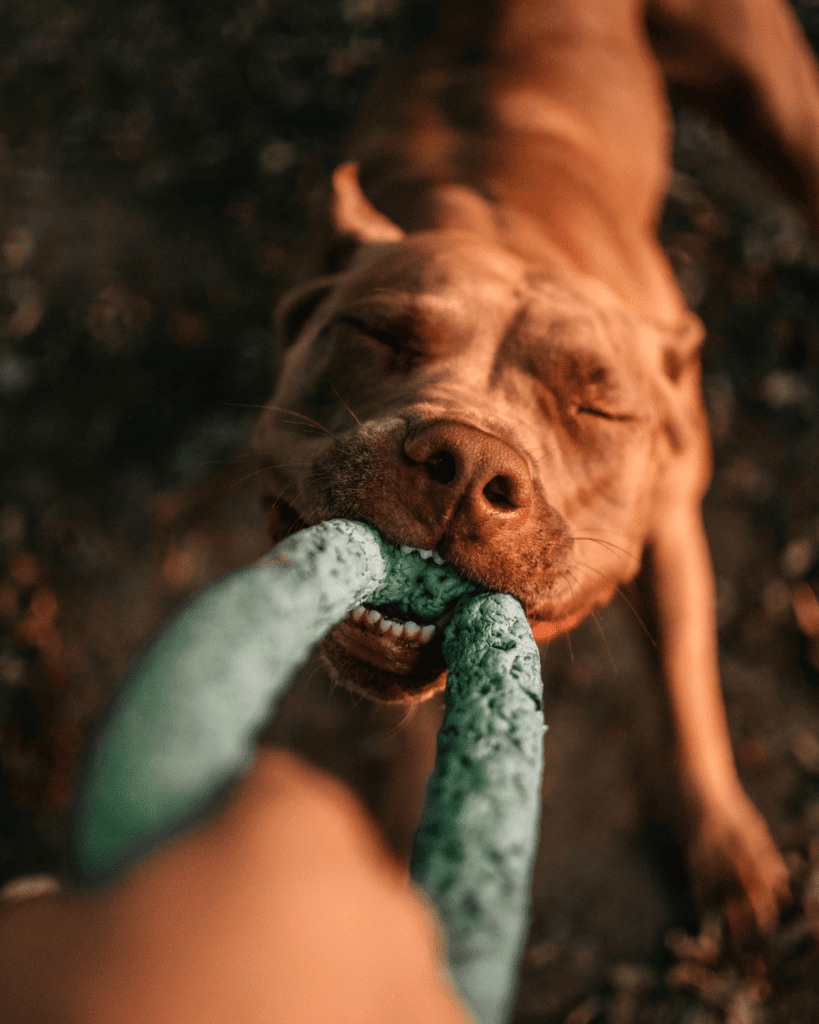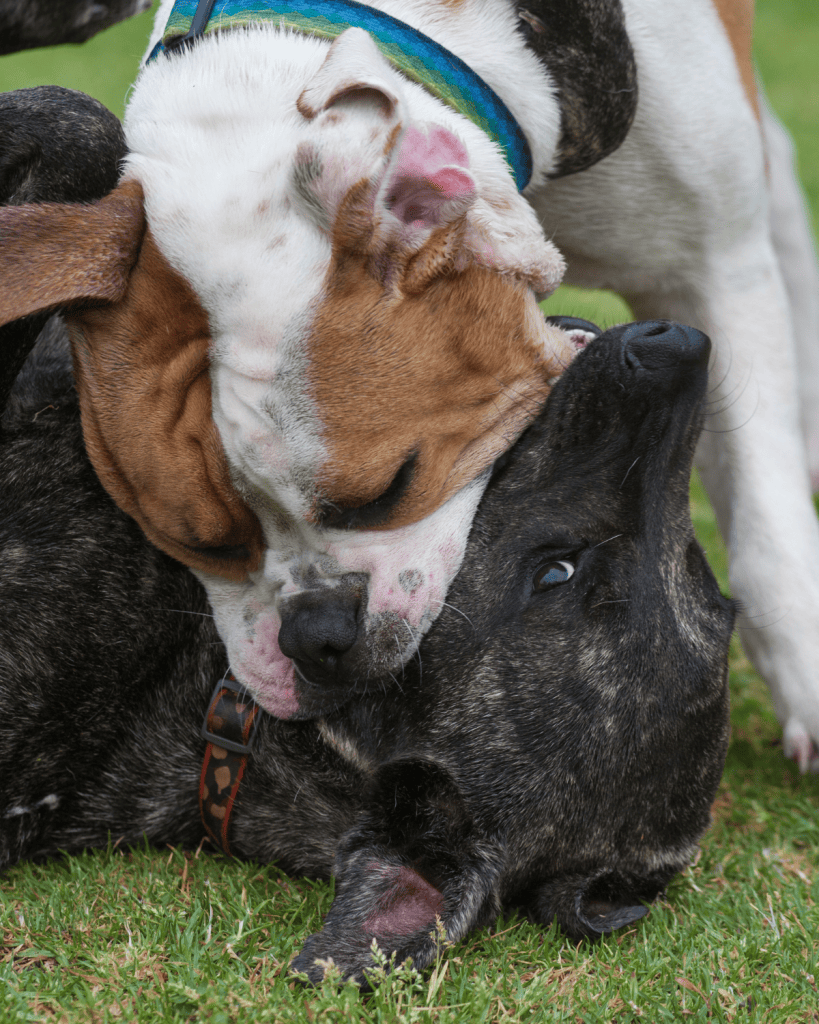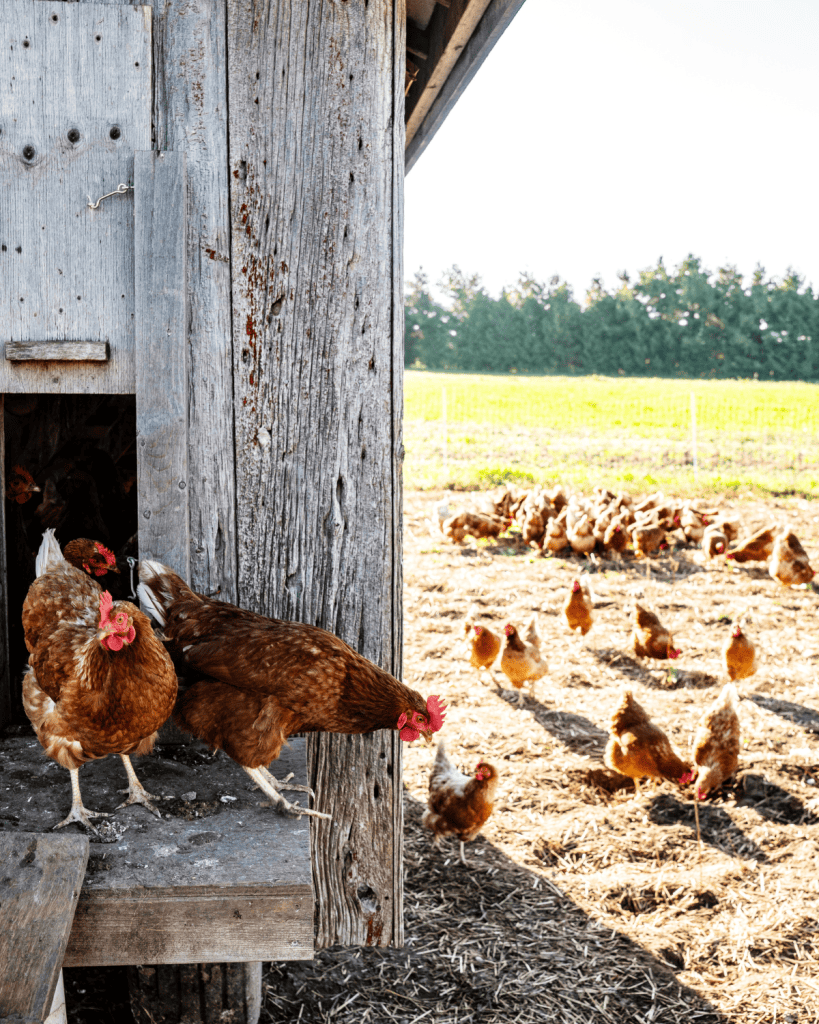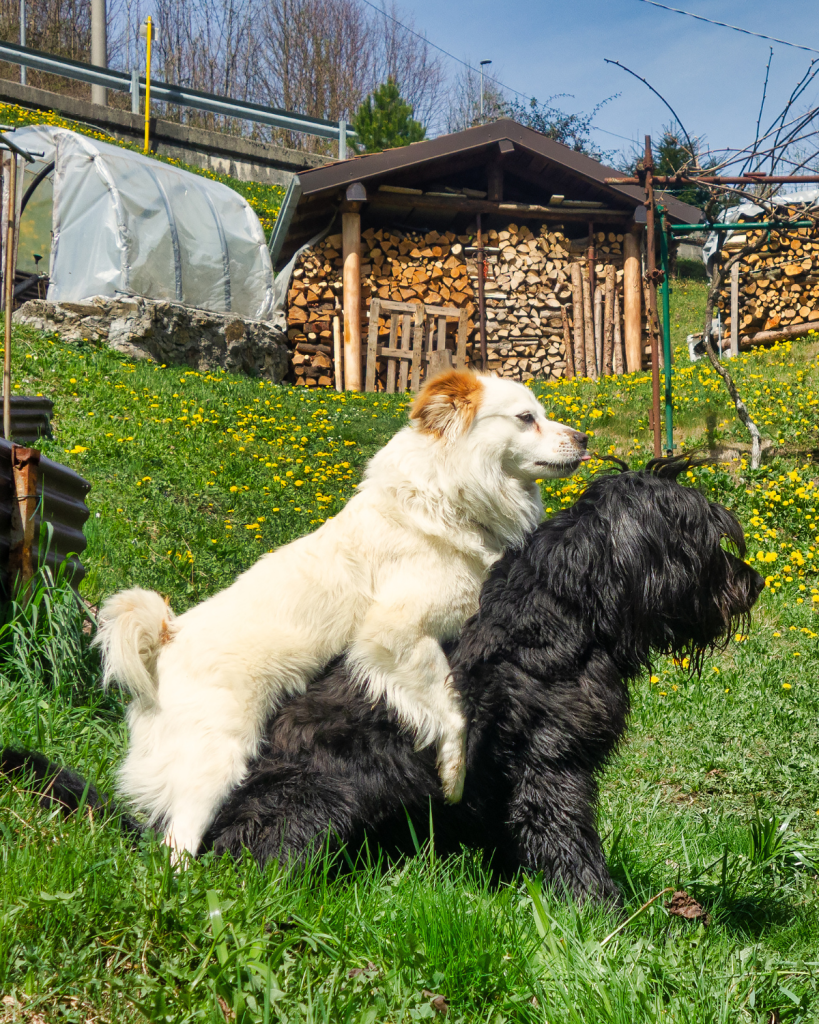As pet owners, our love for our canine companions is as strong as ever, but recent years have seen a shift in our understanding of dog behavior. The old dominance theory, which was once widely accepted by dog trainers, has been debunked by modern trainers and behavioral professionals.
Gone are the days of the “alpha roll” and the “scruff shake,” dog training’s focus has turned towards positive reinforcement techniques to address unwanted behaviour. We’re supremely lucky as dog owners that we don’t need those methods – because I know for a fact that these methods would never have worked for me as a human being. I couldn’t do that and not upset myself
In today’s post, we embark on a journey to discover the truth about the concept of dominance in dogs. We’ll explore how this idea has evolved over time, thanks to the diligent efforts of experts such as John Bradshaw and Dr David Mech. Our exploration begins with the world of wolf packs and top dogs, as we discuss the differences between domestic dogs (Canis familiaris) and their wild counterparts. Along the way, we’ll discuss dominant behaviors and submissive behavior of the past and how we can better understand it today, to help create a nurturing a thriving relationship with our furry friends.

Stay with us as we delve into the complex world of canine behavior. We’ll break down the myths surrounding pack animals, pack leader dynamics, and dominant and submissive body language. Moreover, our journey includes examining the canine social behavior of free-ranging and family dogs, and how these findings have redefined our comprehension of our beloved pets.
So let’s debunk the alpha dog theory together by exploring the various facets of dog world and emerging opinions from trusted training and behavior professionals. By understanding this new perspective on dominance, we can create a more positive and harmonious relationship with our beloved canine companions.
The Myth of Dominance: An explanation of why the dominance theory is outdated and debunked
For many years, the popular belief was that dogs were inherently pack animals, vying for a higher rank to become the ‘alpha’ in the social hierarchies. This notion was built around the assumption that domestic dogs were similar to wolf packs, where an alpha wolf is supposedly the ‘top dog’. However, this understanding of dominance in wolves has been disproved by recent studies and is seen as an outdated and incorrect representation of both dog and wolf behavior.
For one, equating the behaviour of wild wolves, Canis Lupus, to domestic dogs, Canis familiaris is problematic. Domestic dogs and wolves may share a common ancestry, but they are indeed separate species with different behaviors and ecological niches.
Then, to highlight the differences – even socially, Wolves operate as a breeding pair at the head of the pack, with a complex structure built around family ties and hunting in a hostile environment as they try to survive. Domestic dogs, meanwhile, have been bred for companionship and working alongside humans – over several thousand years, their behaviors have diverged significantly from their wild ancestors.

Meanwhile, the studies that initially popularized the ‘alpha wolf’ concept were based on observations of captive wolves – a far cry from the nuanced family dynamics of free-ranging or wild wolves. The observed aggressive behaviors were more indicative of the stress and unnatural conditions of the captive environment than the normal wild wolf behavior.
Crucially, recent years have shown us that even the behavior of wild wolves is far removed from the simplified idea of an aggressive, ‘dominant’ alpha constantly enforcing its status.
A more apt description of a wild wolf pack is a cooperative unit, more akin to a family group than a contentious hierarchy.
Behavior professionals, modern trainers, and respected researchers such as John Bradshaw and the American Veterinary Society of Animal Behavior all echo the same sentiment: the dominance theory is outdated and inaccurate. Dogs, they suggest, display specific behaviors and a much more dynamic as to importance as a response to the immediate environment, limited resources, or individual people, rather than a desire to assert dominance and gain priority access to everything.
Thus, perceiving a dog’s unwanted behavior or aggressive actions as them trying to be ‘dominant’ or the ‘alpha’ is a huge misunderstanding. Instead of focusing on ‘dominant dog’ labels, we need to pay more attention to each specific situation and know that many such behaviors are often signs of fear, anxiety, or simple canine communication.
The good news is that modern dog training advocates for a more knowledgeable, empathetic approach to understanding our canine companions, embracing the complexity and individuality of each dog instead of the antiquated notion of dominance.

Chernobyl’s Dogs: Free Roaming Dogs
It’s hard to find examples of ‘wild’ domestic dogs, or dogs who have constructed a more free and choice-driven way of life. Human life dicates a certain level of control, or rules which make it hard to see a “natural” example of how dogs would behave when choice is a factor.
However, one such example is the free-ranging dogs of Chernobyl, who now populate the once devestated area. These dogs form social groups that are fluid in nature, i.e. they may group as dog A, B and C today, but tomorrow, dog A may find themselves with D, J, and Q. This sort of social structure is very different to the regimented idea of a pack, and a divergence even from what we see in wolves who form family groups.
This behavior can also be observed in street dogs, feral dogs, village dogs and other wild-ish domestic dogs who have a lot of freedom in their life.
This is a huge demonstration that dogs are not pack animals, and don’t have a strict social hierarchy similar to that which dominance implies and can also teach us so much about why dogs are successful at cohabiting and living symbiotically with us humans.
This leads us to the decision that dogs are social animals, but importantly they are not pack animals.
The Shift in Dog Training Methods
In the past, dominance theory perpetuated approaches to dog training that were heavy-handed and harsh, taking cues from a misguided interpretation of the alpha wolf concept. You may remember dog whisperers advocating methods like ‘alpha rolls’, ‘scruff shakes’, or ‘physically forcing a dog into submission’ to reinforce the status of a human as a pack leader (Thanks, Cesar Millan). The main reason behind such techniques was to demonstrate that the human is the alpha and deter dominant dog behaviour. This was once believed to be the way wolves worked because of observations of captive wolf behavior.
Yet, as our understanding of both dog and wolf behaviour has evolved, so too have our training methods. Modern dog trainers and behaviour professionals have made a notable shift away from these outdated concepts and techniques. Positive reinforcement is now heralded as a more appropriate and effective means of training and understanding our canine companions and gave rise to names like “Clicker trainer”, “Force free trainer” and other such nomenclature that trainers use to help overcome a lot of myths and denote their abandonment of aversive methods.

And personally, I do believe the complexities and devolvement of behavior of the modern dog to the misapplication of dominance theory upon the previous generation of dogs, passed down via epigenetics.
Rejecting the premise of the alpha dog and pack theory, positive reinforcement doesn’t rely on fear or submission, but rather encourages good behaviour through rewards and minimises the individual animals errors via management. By giving your dog a treat, praise, or affection when it behaves well (like when it sits on command or doesn’t bark at the postman), you’re increasing the likelihood that behaviour repeating via operant conditioning, specifically, positive reinforcement. Over time, dogs learn to associate these actions with positive experiences, making them more likely to repeat them in the future.
This shift in training has also seen a rise in the popularity of clicker training. This technique uses a sound—usually a click—to tell the dog when they’ve done something right. It takes advantage of the immediate connection between the action and the reward, helping dogs understand what exactly they did to earn their treat. This is far more effective than punitive or dominance-based methods in teaching dogs desired behaviours and commands.
Influential trainers such as Karen Pryor have been integral in popularising these more gentle and humane training techniques in recent years. Reward-based training strengthens the bond between the dog and its owner, reduces the risk of fear or aggression, and is unanimously recommended by animal research and humane organisations.
Indeed, the shift in dog training methods has ushered in a kinder, scientific-based era where dogs are regarded not as creatures striving for dominance, but as what they truly are – our loyal, loving companions.

8 Common Misinterpretations of Dominance & Their Reality
While the concept of dog dominance has been debunked by modern science, misinterpretations still abound. Misunderstood behaviours often lead to dogs being labelled ‘dominant’, which can, in turn, affect their training and interaction with humans. When investigating our dogs’ behavior, it’s crucial to debunk these myths and understand the actual signs expressed by our canine companions. So here are eight things that are really easily misinterpreted
- The Misinterpreted: Jumping Up
Reality: Historically, your dog jumping up may have been viewed as your dog trying to assert dominance in this situation. Instead, dogs generally jump up as a way of greeting people due to their natural face-to-face social interaction. It’s simply their way of saying ‘hello’ and getting our attention. That said, it’s still an irritating and inappropriate behavior we need to train, but we don’t need physical force to do so. If you’re struggling with this, specifically, you may find this helpful: How to Train a Puppy to Stop Jumping Up - The Misinterpreted: Leaning on People
Reality: Dogs that lean on people are often construed as trying to ‘dominate’ their owner. In most cases, it’s actually a sign of affection—or a way of getting some much-wanted attention and contact. This behavior previously would have been something your trainer made you act upon, labelling it as dominance behaviour, luckily, now we know that this is acceptable if the dog’s guardian is happy with it. - The Misinterpreted: Pushing Through Doors
Reality: If your dog nudges past you through the door, this doesn’t necessarily mean they are attempting dominance. Dogs are eager and curious creatures, often going ahead due to their interest in exploring their surroundings. It can be problematic, and it can still be trained, but it still doesn’t need to be punished. - The Misinterpreted: The Aggressive dog
Reality: Most of the time, a dog growls to establish a boundary, it’s not the aggressive actions of the alpha male. Your dog doesn’t do it to ensure they’re seen as the toughest dog on the block. They Fight because of their fight or flight response, and they become reactive because of strong emotions they’re struggling to process in a socially acceptable way – your dog’s motivation isn’t to monopolise the live prey in the area, or even to defend you. Like I said, from our dog’s perspective, the world is kind of a lot.
If you want to dive into this, you may find this helpful: Is There A Difference Between Reactivity & Aggression? - The Misinterpreted: Pulling on the Leash
Reality: Dogs that pull on the leash are not necessarily trying to be ‘pack leaders.’ More likely, they are excited, interested, or not fully leash-trained. They want to smell something, reach another dog, or simply move faster.
Read more: How To Stop Your Dog Pulling On A Leash – The Ultimate Tried and Tested 7 Step Solution - The Misinterpreted: Resource Guarding
Reality: Resource guarding—like over food or toys—can often be misattributed as a sign of dominance. However, it’s more likely a result of fear or anxiety about losing access to valued items. Canine professionals recommend resource guarding be treated with desensitization and counter-conditioning techniques. - The Misinterpreted: Humping
Reality: Many owners perceive humping as a dominant behavior. However, this often has more to do with play, excitement, or stress. Both female and male dogs may exhibit this behavior, and it’s something that you’ll see in various situations from the dog park to your living room, it’s a good idea to look at when it’s happening, and look at it as a symptom rather than a problem. If you’re struggling with Humping, you may check out: Why Does My Puppy Hump? And How Do I Stop It? - The Misinterpreted: Dogs Fighting To Be The Alpha
Reality: Typically a better explanation is that its actually the least confident dog is that is being the aggressor because they’re struggling to feel comfortable. Same as human family dynamics, usually. The pecking order means very little in canine social relationships, normally a “pack fight” (as it may once have been called) denotes an underlying problem, and it might even be a good time to visit a vet to rule out pain and discomfort. - The Misinterpreted: Dog’s show pushy behaviors to be the alpha
Reality: Your dog actually just lacks some manners and you’ve likely not taught pup how to live in your home properly. That one’s really simple.
Awareness of these common misconceptions helps us better comprehend our dogs’ actions—allowing us to train and respond in a way that respects their instincts while maintaining appropriate behavior. Being able to accurately read the body language of our dogs and interpret their actions can only enhance the bond between us and our furry friends, paving the way for better communication, understanding, and companionship. Remember, each dog is an individual with unique behaviors, so these interpretations could vary. Consulting with a behavior professional can provide further clarification if needed.

The Modern Take On Dog Training
As we conclude our explorations into dog dominance and modern dog training methods, it is clear that we have come a long way from outdated notions of pack hierarchy and dominance as we enter the era of reward-based training methods. Misinterpretations of canine behaviors have played a significant role in dog training theories of the past, often spinning simple signs of enthusiasm, fear, or affection into power plays for dominance.
Understanding that fabled alpha behavior, akin to wild wolves, doesn’t apply to our domestic dogs is a giant leap forward. The comparison between wild wolves and domestic dogs has proven to be a flawed analogy, leading to misguided and often punitive training methods. The truth is, our dogs are not trying to climb over us in a mythical rank order. They are, in essence, trying to communicate with us in their own unique ways.
The shift from dominance-based training methods to ones focused on positive reinforcement is a testament to our developing insight into dog behavior. Techniques from the ‘alpha roll’ of the past have been largely replaced with methods built on a foundation of trust, respect, and positive reinforcement, such as reward-based and clicker training.

An understanding of the actual signs our dogs show, instead of practicing outdated definitions of dog behavior, allows us to communicate and live harmoniously with our furry friends. It empowers us to train more effectively, minimize fear, and maintain a strong, positive relationship between us and our loyal companions.
As we continue to grow in our awareness and understanding of dogs, we become not their dominants, but their empathetic caretakers, capable of seeing the world from their singular perspective. Understanding our dogs without the clouded lens of dominance leads to more effective training, happier dogs, and stronger bonds. As we keep debunking old myths and misconceptions, we edge ever closer to a world where dog behavior increases the welfare of the animals we love so dearly.
In this evolving narrative, the message is clear: the magic of the human-dog bond isn’t about dominance—it’s about understanding, empathy, and mutual respect. And that’s a lesson worth learning.
Why Does Dominance Theory Persist?
This is something I’ve been thinking about a lot lately. To me, there’s a number of reasons, but it kind of boils down to greed and a reluctance to change. But let’s discuss why humans don’t seem to want to leave dominance in the past where it belongs.
Human Behavior – We humans find change pretty hard. We’re also likely to be a dominance based species (I mean, isn’t capitalism just modern dominance?) which means dominance theory feels more correct to us because it is probably how our species works.
Not to mention that dominance theory allows the use of aversive tools, which plays into our human nature again where our ecological niche developed because of our ability to use tools – whilst this is conjecture – I do think our overreliance on the use of tools or a fundamental belief that “tools make things easier” is a significant factor.

Money – Just because a thing is no longer true, doesn’t mean that the people who paid for a million episodes of outdated dog training methods aren’t going to leave that available, or books are going to go out of print. If the book continues to sell and the TV show continues to be watched, it’s making someone, somewhere money. And getting over that argument with just ethics is quite hard.
Algorithms – Algorithms actually take a good amount of time to change too, google doesn’t trust just one thing saying everything’s changed – it takes common consensus, so it takes a long time for things to trickle through the algorithms. And Social media? Yuck… it tends to be that those using older methods tend to take more … sensational dog training videos which appeal more or provide more “social proof” that their methods work – where as clicker training, and other more modern methods tend to look a little boring – not to mention that we have different views on our ability to deliberately trigger a dog just for likes on social media. That might not sound like a lot, but when your algorithm is feeding you content to watch and engage with, it will result in you accidentally supporting outdated content.
Family Members – and dog park experts – but we tend to trust them and their insights and when they tell us a thing, we tend to roll with it. Meaning because it worked for someone we truth, we trust it too. It’s hard to know better and be better when sometimes our first dog is brought home when we have just left a family home. We know better now, luckily.
Time & Guilt – for someone to make the change between dominance theory they’ve “seen work” with previous dogs, and adjust to the new world of positive reinforcement, comes with a sense of guilt that can be hard to shake. It’s one thing to be able to admit “I got it wrong” but for that to become “I got it wrong and things could have been so much better for the dogs I loved so dearly before now” is emotionally hard.
Laziness – I hate to raise this one. But punishment and tools often offer a “quick fix”. Because… no one can tell you punishment doesn’t work… and it can work quicker, however it also incites a whack-a-mole like game of dog training where you “get this tool for this, that tool for that, and why is he now doing that too?!” sort of thing.
Then the question becomes “just because it’s quick and it appears to work, does that make it right?” Ethically, as a trainer I don’t think it does, but also, factually, it’s creating a house of cards, where you’re reliant on a tool for an outcome, and when that tool doesn’t work, or doesn’t go to plan, what then? It comes crumbling down…

Want To Take Your Next Steps In Positive Training?
Hopefully, after reading through this, you’re now seeing that wolves and dogs are different species – and that your dog likely isn’t a “dominant dog” and that there’s something else going on there. When we look for that deeper meaning, we find more true results and a better way to help our dogs.
Personally, I implore you to truly dive into this subject, truly assess your dog, and challenge any pre-existing mindsets. Because whilst change is weird for us humans, and we hate to be wrong, sometimes it happens.
Worst comes to worst? You spent however long reinforcing your belief, but when it comes to your best bud? Doesn’t he deserve you thinking critically about his care?
If you want to hone that good behavior in the most modern ways you can, why not look into my guides! They’re a great entry point to the world of positive training. The change can feel steep, but when we start realising the consequences it has for our dogs, and considering how our action makes our dog feel, we suggestly begin to see different meanings when it comes to the interspecies relationship that exists between dogs and humans.
Head to my Etsy Store To Take Your First Steps Into Positive Training.

Author, Ali Smith
Ali Smith is a professional, qualified, and multi-award winning trainer is the founder of rebarkable. She has always believed animals deserve kindness and champions force free methods. Believing that dog guardians will all choose the kindest options if proper information is provided, she aims to help all dog guardians who need it and make dog training as accessible as possible
Ali lives win Maryland, US with her husband and her three dogs.


